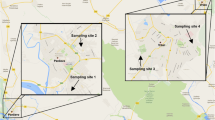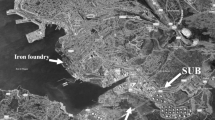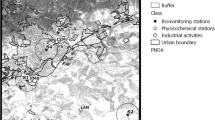Abstract
Due to features that make them outstanding environmental bioindicator, colonies of Apis mellifera are being used to study environmental pollution. The primary objective of this research was to use honeybee colonies to identify heavy metals and determine their utility for environmental management. Five stations each with two A. mellifera hives were strategically located in urban, industrial, agricultural and forested areas within the municipality of Córdoba (Spain), and foraging bees were collected from April to December in 2007, 2009 and 2010 to analyse spatial and temporal variation in Pb, Cr, Ni and Cd pollution. Metal concentrations, in milligram per kilogram of honeybee, were determined by inductively coupled plasma-atomic emission spectrometry and graphite furnace atomic absorption spectrophotometry. Significant differences in concentrations were found among the various locations and periods. The highest number of values exceeding the upper reference thresholds proposed for this study (Pb, 0.7 mg/kg; Cr, 0.12 mg/kg; Ni, 0.3 mg/kg; and Cd, 0.1 mg/kg) was observed for Pb and Cr (6.25 % respectively), station S4 (13.22 %), year 2007 (20.83 %) and in months of May and July (11.90 % each). Regarding the Cd, which was analysed only in 2010, the highest number of values exceeding the upper reference thresholds was 40 %. Biomonitoring with colonies of A. mellifera could contribute to improved surveillance and control systems for atmospheric pollution by integrating qualitative and quantitative assessments, thus facilitating prevention and readiness in the event of environmental crises.










Similar content being viewed by others
References
Acuña, R. (2011). Productos químicos, salud y medio ambiente. http://www.osman.es/noticia/549. Accessed 12 January 2012.
AESAN. Spanish Agency for Food Safety and Nutrition. Ministry of Health, Social Services and Equality (n.d.). Metales pesados. http://www.aesan.mspsi.gob.es/AESAN/web/cadena_alimentaria/subdeta-lle/qui_metales_pesados.shtml. Accessed 7 February 2012.
Bettinelli, M., & Terni, C. (2000). Determination of trace elements in honey by ICP-MS. In C. Minoia, M. Bettinelli, A. Ronchi, & S. Spezia (Eds.), Application of ICP-MS in chemical and toxicological laboratory (pp. 341–349). Milan: Morgan.
Bromenshenk, J. J. (1986). Public participation in environmental monitoring: a means of attaining networks capability. Environmental Monitoring and Assessment, 6(1), 35–47.
Bromenshenk, J. J., Henderson, C. B., & Smith, G. C. (2002). Biological system, paper II. In J. A. MacDonald & J. R. Lockwood (Eds.), Alternatives for landmine detection (pp. 273–283). RAND: MR-1608-OSTP.
Celli, G., & Maccagnani, B. (2003). Honey bees as bioindicators of environmental pollution. Bulletin of Insectology, 56, 137–139.
Citak, D., Silici, S., Tuzen, M., & Soylak, M. (2012). Determination of toxic and essential elements in sunflower honey from Thrace Region, Turkey. International Journal of Food Science & Technology, 47(1), 107–113.
Codreanu, I., Sfetcu, M., Codreanu, M., & Goran, G. (2009). Correlations between the lead residues in honey bees and the apiary location. Lucrári Stiintifice Mediciná Veterinará, XLII(2), 301–305.
Crane, E. (1984). Bees, honey and pollen as indicators of metals in the environment. Bee World, 65(1), 47–49.
Devillers, J., Doré, J. C., Viel, C., Marenco, M., Poirier-Duchène, F., Galand, N., & Subirana, M. (2002). Typology of French acacia honeys based on their concentrations in metallic and nonmetallic elements. In J. Devillers & M. H. Pham-Delègue (Eds.), Honeybees: estimate the environmental impact of chemicals (pp. 248–266). London: Taylor & Francis.
Devillers, J., & Pham-Delègue, M. H. (2002). Honeybees: estimate the environmental impact of chemicals. London and New York: Taylor & Francis.
Directorate General of Prevention and Environmental Quality. Regional Government of Environment. Junta de Andalucía (2010). Plan de Mejora de la Calidad del Aire de la Agomeración de Córdoba (Anexo 10).
EC (2004). Directive 2004/35/CE of the European Parliament and of the Council of 21 April 2004 on environmental liability with regard to the prevention and remedying of environmental damage. DO L 143 de 30.4.2008, p. 56/75.
EC (2005). Directive 2004/107/EC of the European Parliament and of the Council of 15 December 2004 relating to arsenic, cadmium, mercury, nickel and polycyclic aromatic hydrocarbons in ambient air. DO L 23 de 26.1.2005, p. 3/16.
EC (2008). Directive 2008/50/EC of the European Parliament and of the Council of 21 May 2008 on ambient air quality and cleaner air for Europe. DO L 152 de 11.6.2008, p. 1/44.
EC (2010). Directive 2010/75/EC of the European Parliament and of the Council of 2 November 2010 on industrial emissions (integrated pollution prevention and control). DO L 134 of 17 December 2010, p. 17/119.
European Environment Agency. (2010). The European environment: state and outlook 2010. European Environment Agency, Copenhagen: Synthesis.
European Environment Agency (2011). Heavy metal (HM) emissions (APE 005). Available in: http://www.eea.europa.eu/data-and-maps/indicators/eea32-heavy-metal-hm-emissions-1/assessment-1. Accessed 8 March 2012.
Garty, J. (2002). Biomonitoring heavy metals pollution with lichens. In I. C. Kranner, R. P. Beckett, & A. K. Varma (Eds.), Protocols in lichenology. Culturing, biochemistry, ecophysiology and use in biomonitoring (pp. 458–482). Berlín: Springer.
Gnes, A., Rondinini, T., Pari, E., Fonti, P., Vincenzi, D., Speranza, A., & Calzoni, G. L. (2004). Mason bees and environment. Insect Social Life, 5, 111–116.
Government of Spain (2011). (2011). Real Decreto 102/2011, de 28 de enero, relativo a la mejora de la calidad del aire. Boletín Oficial del Estado (BOE), n° 25(sec. I), 9574–9626.
Institute of Statistics and Cartography of Andalucía. Regional Government of Economy, Innovation, Science and Employment (n.d.). http://www.juntadeandalucia.es/institutodeestadisticaycartografia. Accessed 4 December 2011.
Kettlewell, H. B. D. (1958). A survey of the frequencies of Biston betularia (L.) (Lep.) and its melanic forms in Great Britain. Heredity, 12, 51–72.
Lighthart, B., Prier, K. R. S., & Bromenshenk, P. J. (2004). Detection of aerosolized bacterial spores (Bacillus atrophaeus) using free-flying honey bees (Hymenoptera: Apidae) as collectors. Aerobiología, 20(4), 191–195.
Lighthart, B., Prier, K. R. S., & Bromenshenk, P. J. (2005). Flying honey bees adsorb airborne viruses. Aerobiología, 21(2), 147–149.
LANL Los Alamos National Laboratory (2006). The Stealthy Insect Sensor Project: bees in a box (BIB). http://www.youtube.com/watch?v=_T7d0bze4kM. Accessed 11 October 2011.
Machado, A., García, N., García, C., Acosta, L., Cordova, A., Linares, M., Giraldoth, D., & Velásquez, H. (2008). Contaminación por metales (Pb, Zn, Ni y Cr) en aire, sedimentos viales y suelo en una zona de alto tráfico vehicular. Revista Internacional de Contaminación Ambiental, 24(4), 171–182.
Medicinatv.com. Parque Azahara está en contacto con salud por riesgos de enfermedades a causa de las emisiones contaminantes. News 27-08-09. http://www.medicinatv.com/noticias/andalucia-parque-azahara-esta-en-contacto-con-salud-por-riesgos-de-enfermedades-a-causa-de-las-emisiones-contaminantes-200569. Accessed 7 September 2009.
Pérez, P. (2005). Retos futuros de la exposición personal a contaminantes en aire. Revista de Salud Ambienta, 5(2), 175–180.
Perugini, M., Manera, M., Grotta, L., Abete, M. C., Tarasco, R., & Amorena, M. (2011). Heavy metal (Hg, Cr, Cd and Pb) contamination in urban areas and wildlife reserves: honeybees as bioindicators. Biological Trace Element Research, 140(2), 170–176.
Porrini, C., Ghini, S., Girotti, S., Sabatini, A. G., Gattavecchia, E., & Celli, G. (2002). Use of honey bees as bioindicators of environmental pollution in Italy. In J. Devillers & M. H. Pham-Delègue (Eds.), Honeybees: estimate the environmental impact of chemicals (pp. 186–247). London and New York: Taylor & Francis.
Porrini, C., Sabatini, A. G., Girotti, S., Ghini, S., Medrzycki, P., Grillenzoni, F., Bortolotti, L., Gattavecchia, E., & Celli, G. (2003). Honey bees and bee products as monitors of the environmental contamination. Apiacta, 38(1), 63–70.
Querol, X. (2008). Calidad del aire, partículas en suspensión y metales. Revista Española de Salud Pública, 82(5), 447–454.
Rashed, M. N., El-Haty, M. T. A., & Mohamed, S. M. (2009). Bee honey as environmental indicator for pollution with heavy metals. Toxicological & Environmental Chemistry, 91(3), 389–403.
Roman, A. (2005). The influence of environment on accumulation of toxic elements in honey bees body. http://www.isah-soc.org/documents/2005/sections/99_vol_2.pdf. Accessed 12 January 2012.
Roman, A. (2010). Levels of copper, selenium, lead, and cadmium in forager bees. Polish Journal of Environmental Studies, 19(3), 663–669.
Ruiz, J. A., Gutiérrez, M., & Porrini, C. (2013). Biomonitoring of bees as bioindicators. Bee World, 90(3), 61–63.
Serra-Bonvehí, J., & Orantes, F. J. (2013). Element content of propolis collected from different areas of South Spain. Environmental Monitoring and Assessment, 185(7), 6035–6047.
Shaw, J. A., Seldomridge, N. L., Dunkle, D. L., Nugent, P. W., Spangler, L. H., Bromenshenk, J. J., Henderson, C. B., Churnside, J. H., & Wilson, J. J. (2005). Polarization lidar measurements of honey bees in flight for locating land mines. Optics Express, 13(15), 5853–5863.
Silici, S., Uluozlu, A. D., Tuzen, M., & Soylak, M. (2008). Assessment of trace element levels in Rhododendron honeys of Black Sea Region, Turkey. Journal of Hazardous Materials, 156(1–3), 612–618.
Thwaites, T. (2010). Policing genes. http://www.thomasthwaites.com/policing-genes/ Accessed(12 December 2011).
Tuzen, M., & Soylak, M. (2005). Trace heavy metal levels in microwave digested honey samples from Middle Anatolia, Turkey. Journal of Food and Drug Analysis, 13(4), 343–347.
US-EPA. U.S. Environmental Protection Agency (2007a). Inductively coupled plasma-atomic emission spectrometry—Method 6010C 2007
US-EPA. U.S. Environmental Protection Agency (2007b). Graphite furnace atomic absorption spectrophotometry—Method 7010 2007
Van der Steen, J. J. M., de Kraker, J., & Grotenhuis, T. (2012). Spatial and temporal variation of metal concentrations in adult honeybees (Apis mellifera L.). Environmental Monitoring and Assessment, 184(7), 4119–4126.
Van der Steen, J. J. M., de Kraker, J., & Grotenhuis, T. (2015). Assessment of the potential of honeybees (Apis mellifera L.) in biomonitoring of air pollution by cadmium, lead and vanadium. Journal of Environmental Protection, 6(2), 96–102.
WHO. World Health Organization. (2007). Health relevance of particulate matter from various sources. Bonn, Germany: Report on a WHO Workshop.
Acknowledgments
This work has been supported by two funders: the Córdoba City Council through the “Evaluation of urban pollution in the municipality of Córdoba using colonies of Apis mellifera as environmental bioindicators” project (Ref: 2006/000228) and the Spanish Ministry of Environment through the “Network of biomonitoring stations using colonies of Apis mellifera for real time assessment of urban pollution in the city of Córdoba” project (PC 199-003, 2008–2011).
Author information
Authors and Affiliations
Corresponding author
Rights and permissions
About this article
Cite this article
Gutiérrez, M., Molero, R., Gaju, M. et al. Assessment of heavy metal pollution in Córdoba (Spain) by biomonitoring foraging honeybee. Environ Monit Assess 187, 651 (2015). https://doi.org/10.1007/s10661-015-4877-8
Received:
Accepted:
Published:
DOI: https://doi.org/10.1007/s10661-015-4877-8




